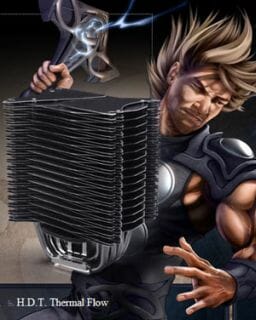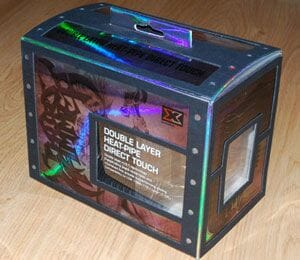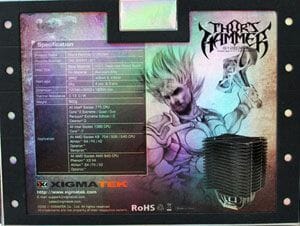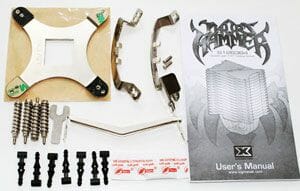XIGMATEK’s Thors Hammer Cooler Review

Don’t worry, our today’s article is not going to talk about the role of ancient weaponry in myths and legends. It is just that XIGMATEK chose a name like that for their new cooler. Well, let’s see how interesting and effective the new cooling solutions turned out.
The German-Scandinavian mythology has a god of thunder, storms and fertility. His name is Thor. Thor travels in a bronze chariot, wears a pair of iron gloves needed to hold the red-hot weapon and a magic belt which boosts the wearer’s strength. As for the weapon, Thor owns a short-handled hammer, which, when thrown at a target, returns magically to the owner and also has the power to throw lightning bolts. It is the latter that XIGMATEK Co., Ltd. have chosen as inspiration for their new CPU cooler called Thor’s Hammer (SS126384).

This cooling system really turned out very interesting: it boasts very innovative heatsink design and great cooling efficiency, so we couldn’t miss the opportunity to check it out. So today, we are proud to offer you a detailed review of this solution.
Package and Accessories
The box Thor’s Hammer comes in is of average size. It is designed as an ancient chest with panels looking like metal along the perimeter of the box:

There are small cut-out windows on the front and back of the box that reveal part of the cooler heatsink and its base. The back of the box has detailed cooler specifications and a small photo against the background of fierce god Thor:

The cooler sits between two plastic molds inside the box. The accessories are sealed in a plastic bag sitting on top of one of them:

The accessories include the following items:
- Universal backplate with padding for LGA775 and LGA1366 mainboards;
- Two steel retention brackets for LGA775 and LGA1366 platforms with screws;
- Four spring-screws and a small wrench;
- Retention swing-clip for contemporary mainboards for AMD CPUs;
- Eight silicon spindles for the fans;
- A 1g pack of Stars thermal interface;
- Installation instructions.
The cooler comes without a fan. It is made in China, a country where Thor has barely ever been to. The recommended price for XIGMATEK Thor’s Hammer is set around $60.
Design and Functionality
XIGMATEK Thor’s Hammer doesn’t look anything like an axe or a hammer, but it has all the features of a typical tower-type processor cooling solution.
Nevertheless, this pretty heavy 800-gramm heatsink measuring 120 x 90 x 160 mm may one day become a really serious weapon. As for us, we are mostly interesting in its ability to fight high heat dissipation of modern processors, so let’s move on with our story.
The heatsink is built on four copper nickel-plated heatpipes, each 8mm in diameter, that also form part of the cooler base (HDT technology). There is another row of three heatpipes above them. These ones are 6mm in diameter. The heatpipes hold aluminum nickel-plated plates of four different shapes.
Two top plates serve mostly decorative purposes, because they do not contact the heatpipes. Then we see an almost oval plate with an elongated hole in the center. There are 16 plates like that and they alternate with the plates of third type of a very sophisticated shape that I cannot describe. There are 32 of those. At the bottom of the heatsink there are three small oval plates.
The heatsink plates are spaced out at 2mm from one another and are of the same thickness: 0.45mm. Despite very complex heatsink plates shapes (there are 54 plates total) we managed to calculate the effective surface size that makes 7,738sq.cm. It is about the same as ThermoLab BARAM has, but is smaller than that of Scythe Mugen 2.
The unique shapes of heatsink plates and their shifted positioning in the array allowed to significantly reduce the fan airflow resistance.
Besides a total of 7 heatpipes, there are six square metal rods coming out of the cooler base. Their purpose is unknown to us, because they contact only the three lower plates, while the main heatsink array sits on the heatpipes.
The cooler base is protected with clear plastic film warning you that it needs to be removed before cooler installation. The cooler base is even and features decent finish.
I have to say that the aluminum insert between the heatpipes is a tiny bit taller than the heatpipes surface. The heatpipes in the cooler base are at 1.5mm from one another and as we see from the thermal interface imprint all four of them contact the processor heat-spreader.
I would like to remind you once again that XIGMATEK Thor’s Hammer comes without a fan. However, there are eight silicon spindles bundled with it that should be used for fan installation. They go into special grooves in the heatsink array.
You can use these spindles to install two fans onto XIGMATEK Thor’s Hammer heatsink, although they will add a little more to the already high cooler price.
Compatibility and Installation
XIGMATEK Thor’s Hammer is designed to fit onto LGA775/1366 and Socket 754/939/AM2(+)/AM3 mainboards. In the latter case you should use the enclosed swing-clip that catches on to the hooks in the standard plastic socket frame.
As you understand, you won’t need to remove the mainboard from the system case. The cooler in this case may be installed in two different positions.
When using the Hammer on a contemporary Intel platform, things get a little more complicated, as you will need to remove the board from the system case. First you stick the backplate to the bottom of the mainboard PCB. It is the same backplate for both: LGA775 and LGA1366.
So, when you upgrade from LGA 775 to LGA1366, all you need to do is turn the backplate around. Then you fasten the steel retention brackets to the base with included screws.
And then simply install the cooler onto the CPU and tighten the spring screws to the backplate.
You can use a regular cross-head screwdriver for two of the four screws. The other two screws that get beneath the heatsink plates will need to be tightened using the enclosed little wrench. The retention is extremely secure and since the 775/1366 socket retention holes are symmetrical, you will be able to turn the cooler any way you like.
By the way, since we mentioned the cooler positioning on the PCB. The tests were performed with the cooler installed two different ways: with the airflow directed towards the back of the system case.
…and with the airflow directed towards the top of the system case.
The peak CPU temperature was constantly 2°C lower in the second case than in the first one. However, we only saw this difference when we used XIGMATEK Thor’s Hammer with only one fan. If there were two fans installed for air intake and exhaust, there was no efficiency difference between the cooler installations.
Testbed and Methods
Our testbed was identical for all coolers throughout the test session and featured the following configuration:
- Mainboard: ASUS P6T Deluxe (Intel X58 Express), LGA 1366, BIOS 1303;
- Processor: Intel Core i7-920, 2.67GHz, 1.25V, 4 x 256KB L2, 8MB L3 (Bloomfield, C0);
- Thermal interface: Arctic Silver 5;
- Graphics card: ZOTAC GeForce GTX 260 AMP2! Edition 896MB, 648/1404/2108MHz (1030RPM);
- Memory: DDR3 3 x 1GB Corsair DOMINATOR TWIN3X2048-1800C7DFIN (Spec: 1800MHz / 7-7-7-20 / 2.0V);
- Disk subsystem: Western Digital VelociRaptor (SATA-II, 300GB storage capacity, 10,000RPM, 16MB cache, NCQ);
- HDD silencer and cooler: Scythe Quiet Drive 3.5”;
- Optical drive: Samsung SH-S183L;
- System case: Antec Twelve Hundred (default 120mm fans replaced with Scythe Slip Stream 120 fans at 800RPM; 120-mm Scythe Gentle Typhoon at 800RPM installed on the lower front of the case; standard 200-mm fan at 400RPM at the top of the case);
- Control and monitoring panel: Zalman ZM-MFC2;
- Power supply: Zalman ZM1000-HP 1000W (with a default 140 mm fan).
During CPU overclocking we activated in the mainboard BIOS the “Load-Line Calibration” function that lowers the voltage drop on the part of the voltage regulator circuitry before the CPU. The system memory voltage was locked at 1.55V and its frequency started at 1500MHz (8-8-8-18 timings) and up. All other parameters available in the mainboard BIOS and connected with CPU or memory overclocking remained unchanged (set to Auto). Processor power-saving technologies were disabled during the test session. SMT was on.
All tests were performed under Windows Vista Ultimate Edition x86 SP1. We used the following software during our test session:
- Real Temp 3.19b – to monitor the processor core temperature;
- Linpack 32-bit with LinX shell version 0.5.7 – to create maximum CPU load (two test cycles, 15 Linpack runs in each cycle with 1624MB RAM capacity involved);
- RivaTuner 2.24 – to visually control temperature changes (with RTCore plugin).
We tested all coolers at least twice for each fan operation mode. The stabilization period for the CPU temperature between the two test cycles was about 10 minutes. We took the maximum temperature of the hottest processor core of the four for the results charts. The ambient temperature was checked next to the system case with an electronic thermometer with 0.1°C precision that allows monitoring the temperature changes over the past 6 hours. During our test session room temperature stayed at 23.5-24°C.
We tested XIGMATEK Thor’s Hammer and its today’s competitor with two Enermax Magma fans. The fans were installed for air intake and exhaust.
The “war hammer” will be competing against “second infinity” in our today’s tests: Scythe Mugen 2 cooler.
According to our latest (and far not the last) cooler mega-shootout, Mugen 2 is currently the best solution from the efficiency-to-price standpoint. That is why our today’s hero as well as upcoming new solutions will have to challenge Mugen 2.
Cooling Efficiency Tests
First of all let’s check out the processor overclocking potential under XIGMATEK Thor’s Hammer with different number and type of fans at different rotation speeds. To accomplish this experiment we used not only the above mentioned Enermax Magma fans, but also SilentX iXtrema Pro IXP-76-18 fans (120 x 120 x 38 mm) with maximum 1520RPM rotation speed (according to monitoring tools).
Note how beautifully the fans match the color of the heatsink! When XIGMATEK Thor’s Hammer is installed with the airflow directed towards the back of the case, the whole cooling system wouldn’t fit into the case anymore that is why we only installed the cooler as shown above.
The mode that is marked as “passive” on the graph is actually “relatively passive”, because the airflow inside the system case is very effective. But even the quiet system maniacs will be able to overclock their processors quite noticeably with XIGMATEK Thor’s Hammer with one or, better, two fans only at 540RPM. You could push the CPU frequency even higher with a pair of more powerful fans. But I believe that the optimal solution for this heatsink would be one or two fans at 1200RPM. Two 38-mm fans, unfortunately, do not provide the anticipated temperature drop and big increase in the maximum CPU frequency during overclocking.
And now let’s compare the cooling efficiency of our today’s main hero against that of Scythe Mugen 2. Both coolers were tested only with two fans, since we have already discussed the results for XIGMATEK Thor’s Hammer above (feel free to check out the dependence of Mugen 2 efficiency on the number and speed of fans in our previous review). Here we go.
Despite great cooling efficiency of the “war hammer”, it yields to Scythe Mugen 2. And if in quiet mode (at 840RPM fan rotation speed) the difference reaches 5°C, then at twice as high fan speed the gap reduces to only 2°C.
In conclusion I would like to compare the results of our today’s hero against those from our recent mega-shootout. The room temperature and other testing conditions as well as thermal interface remained exactly the same. The only things that are different in our today’s test session are: the BIOS version of the mainboard (V1206 → v1303), RealTemp monitoring program version (v3.07b → v3.19b), and a little more RAM was used during Linpack test (1600MB → 1624MB). Nevertheless, we still would like to add our “war hammer” to this chart.
With an advantage of a second fan XIGMATEK Thor’s Hammer joins the group of the today’s best coolers.
Conclusion
XIGMATEK Thor’s Hammer proved not only a good cooler for extremely hot overclocked CPUs, but took a well deserved place among the best air coolers. At this point it is important to understand that Thor’s Hammer needs two fans instead of one to be installed on it in order to reveal its full potential. Therefore, you have to add another $10-$15 for a pair of high-quality fans to the already pretty high price of the cooler (around $60). The complete cooling solution turns out not so cheap in the end, so it may be pretty hard for it to compete against Scythe Mugen 2 or even Thermalright Ultra-120 eXtreme-1366 RT. Actually, the price of the cooler is that one thing that we are not very happy about in regards to XIGMATEK Thor’s Hammer: everything else about this cooler is superb. As far as we know, XIGMATEK is going to lower the price of their Thor’s Hammer cooler shortly. I guess we will have to wait and see how low they are willing to go. 🙂